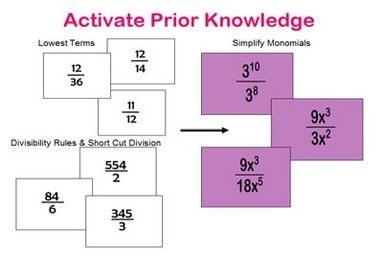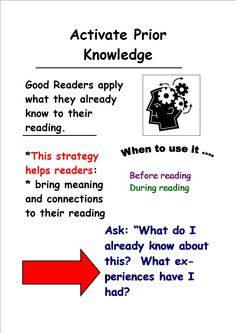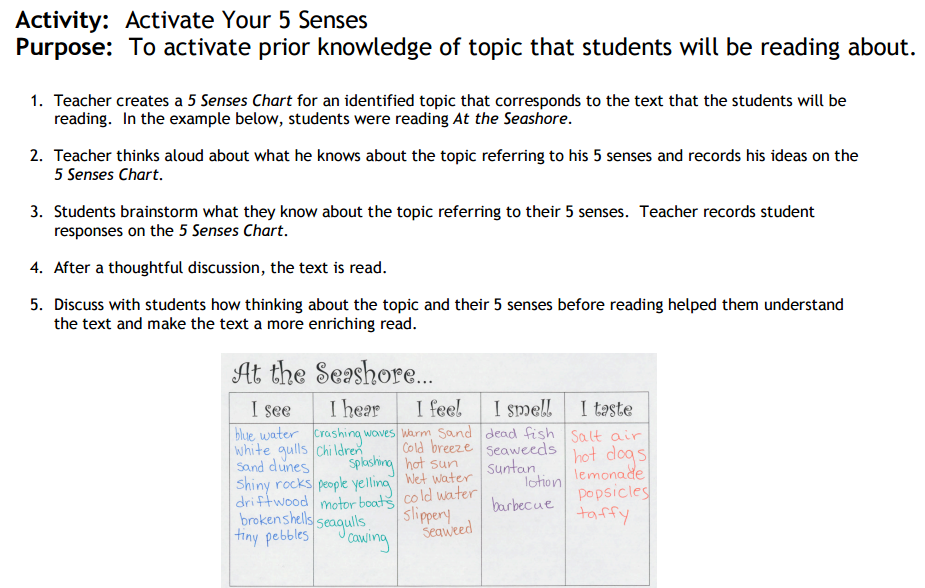"Activating prior knowledge is something that we do naturally as adult readers, as mature readers. We always relate what we're reading to something we know. As a matter of fact when we read we really have to think about those connections. Sometimes students don’t access their background knowledge because they never think that it's important or if they don’t have the background knowledge the teacher doesn’t have an opportunity to really build that background knowledge" (Clewell, 2012).
|
Purpose: To help them make connections of prior knowledge and apply it into the new material. This helps students understanding what they are reading. Since background knowledge is made up of a person's experiences with the world, with his or her concepts for how written text works, word identification, print concepts, word meaning, and how text is organized, students are constantly able to apply prior learning into the new information.
|
Tips:
|

Content Area Examples:
Reading:
Reading:
- Questioning before, during, or after a story.
- Have students share an experience related to the topic with a partner.
- Relating a story that might be in their culture, such as Cinderella is in many different cultures
- Questioning before, during, or after lesson, activity, etc.
- Have student relate new material to existing, for example how does adding and subtracting relate.
- How can you use same math strategies in a new concept, example how does problem solving tie over from adding to subtracting.
- The picture to the right demonstrates how students can use their prior knowledge in math. It is showing how using prior knowledge can eliminate taking the load road to solve a problem and simply using short cuts about what we already know to solve!
- Questioning before, during, or after lesson, activity, etc.
- Real life experience they have has related to the topic.
Lesson Example: The lesson below demonstrate how students can use more than just information, but they can also use their prior experience, such as sense, to help understand a book. This would help ELLs because even though our language is different our sense are the same, unless there is a disability. This lesson example demonstrates how this strategy is one way that ELLs can use what they have already experiences, including there senses, and apply it to something completely new.
(Into the book, 2015)
(Into the book, 2015)
Additional Links for: Information, Lessons, and Material
References:
Echevarría, J., Vogt, M. E., & Short, D. (2013). Making content comprehensible for Elementary English language learners: The SIOP model. Boston, MA: Allyn & Bacon.
Gunning, T. G. (2012). Creating literacy instruction for all children in grades pre-K to 4. 2nd Edition. Boston: A and B.
Into the book: Reading Resources (2015). Activating your five senses lesson. [imagine] Retrieved on September 18, From http://reading.ecb.org/
Stec, M., (2014).Prior knowledge (Schema) Anchor Char). [imagine]. Retrieved September 18, From 2015.https://www.pinterest.com/pin/182184747401665335/
Wayne Township HOSTS (n.d). [Chart with definition and use before and during reading]. Retrieved September 18, From
http://www.wayne.k12.in.us/hosts/reading_strag.asp
Echevarría, J., Vogt, M. E., & Short, D. (2013). Making content comprehensible for Elementary English language learners: The SIOP model. Boston, MA: Allyn & Bacon.
Gunning, T. G. (2012). Creating literacy instruction for all children in grades pre-K to 4. 2nd Edition. Boston: A and B.
Into the book: Reading Resources (2015). Activating your five senses lesson. [imagine] Retrieved on September 18, From http://reading.ecb.org/
Stec, M., (2014).Prior knowledge (Schema) Anchor Char). [imagine]. Retrieved September 18, From 2015.https://www.pinterest.com/pin/182184747401665335/
Wayne Township HOSTS (n.d). [Chart with definition and use before and during reading]. Retrieved September 18, From
http://www.wayne.k12.in.us/hosts/reading_strag.asp


